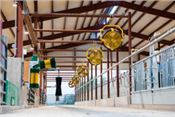Don’t Let Heat Stress Rob Your Summer Milk Income
LEXINGTON, KY.
Dairy cattle are usually the most comfortable when outside temperatures are between 40 and 70 degrees Fahrenheit. With temperatures already rising into the 80s, dairy producers need to be vigilant about keeping cows comfortable so heat stress doesn’t become the thief of summer dairy income.
“Heat stressed cattle eat less and don’t milk or grow as well,” said Jeffrey Bewley, dairy specialist for the University of Kentucky College of Agriculture, Food and Environment. “Dairy cattle can drop 5 to 10 pounds of milk during summer heat spells.”
June is National Dairy Month, and it’s a good time for producers to review their management practices to see what changes they can make to help cows cope with summer heat and humidity.
Balancing rations for summertime feeding can be different from other times of the year. Cows don’t eat as much dry matter in hotter and more humid conditions, but they may need more mineral concentrations of potassium, sodium and magnesium.
“When cows sweat, they lose potassium, so their diet needs to contain about 1.5 percent more potassium in the summer,” Bewley said. “You really want a ration that supports milk production and also contains enough fiber.”
It usually takes about four hours after feeding for the digesting heat load to peak, so feeding cows earlier in the morning will help ensure that doesn’t happen during the hottest part of the day. Cleaning out feedbunks every day can keep feed from heating up, which can discourage cows from eating.
“If you mix and feed at least twice a day, cows will likely eat more and get adequate nutrition for optimum summer milk production,” Bewley said.
When temperatures climb above 70 to 75 degrees Fahrenheit, it’s a good idea to turn on fans and sprinklers to help cool cows. They wet the cows’ coat and cause evaporative cooling. These systems placed over feedbunks can encourage cows to eat more feed; placed in the resting area, they encourage cows to lie down and ruminate or rechew their cud. Fans and sprinklers in the holding pen of the milking parlor can cool cows waiting to be milked and when they exit the area.
Since milk is about 87 percent water, getting cows to drink enough water during times of heat stress is very important. Keeping the waterers clean encourages cows to drink more.
“There is a direct relationship between water intake and feed intake,” Bewley said. “Cows have to drink enough to eat enough, and they have to eat enough to produce milk.”
Bewley said heat stress is a hot research topic at land-grant universities across the country. Recent studies all conclude that heat stress can negatively affect cows by increasing the cow’s panting and respiration rate, rectal temperature rate, postpartum disease rate, and it can decrease their pregnancies per artificial insemination. Heat stress can also decrease their passive immunity capability.
“What I take from much of the new studies is that fans and soakers really do help to alleviate heat stress,” he said. “I also agree that cooling dry cows may help increase the passive immunity capability of their calves, and inseminating cows during heat stress may increase the cow’s risk for disease. But with proper management during the heat and humidity of summer, we can avoid most of these issues.” ∆

Fans help cattle cope with heat and humidity.
PHOTO: Stephen Patton, UK Agricultural Communications Specialist